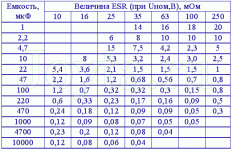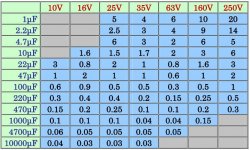I've been waiting for someone to mention the time aspect 🙂
If you charge a suitable 1000uF cap to 100.00 volts and then remove the charging voltage after say 1 hour, how long before the voltage falls to 99.00 volts ?
Answers on a post card 😉
If you charge a suitable 1000uF cap to 100.00 volts and then remove the charging voltage after say 1 hour, how long before the voltage falls to 99.00 volts ?
Answers on a post card 😉
that kind of meter is probably using a few seconds time to charge and the same time in uncharging cycle to check how much %V leaked out?
Here's an article:
"A bad capacitor is an electronics component that over the course of its life has turned to the dark side. It is evil now and is no longer serving its intended purpose in life.
A voltage loss of 34% is terrible! This part is leaking electricity like a sieve.
Vloss is the amount of voltage the meter has measured that the capacitor has lost.
This part is leaking electricity like a sieve. Which is not what capacitors are supposed to do at all. Quite the opposite in fact. Capacitors are supposed to be able to store electricity. They are supposed to have the capacity to store an electrical charge. Hence their name. The ESR measurement is pretty bad too, but not nearly as out of spec as the Vloss."
I think bad Vloss is electricity that escape unfiltered ? so the bigger the V-loss the bigger the chance the cap will act like a good conductive wire ?.
A Vloss of 80% will be almost like a perfect conductive wire ?
So a cap os 10000uf having a Vloss of 2% means some serious unfiltered current that is escaping creating overheat and maybe damage to other components?
Apart from then obvious meaningless drivel, it *appears* that they define the 'V-loss' as the voltage drop when they put a meter on the cap, and watch the voltage drop as the cap discharges.
If they knew what they were talking about, which clearly they are not, they would realize that this is mainly the effect of the discharge through the meter, so what they measure is the meter impedance! It does say almost nothing about the capacitor.
I would avoid this stuff like the plague and continue to enjoy your amplifier.
IF you are worried about the capacitor after so many years, check its capacitance. As long as it has 70%-80% of the label or above you're OK. Note that those large caps at the time were often specified as -50%/+100% tolerance anyway.
Jan
Edit: I should mention that even if that cap has a leakage current of a few mA, that has no, zero, nada, zilch effect on its work to store charge anyway.
That isn't an article, just some vague woffle. It sems to imply that Vloss may be a measure of leakage, without actually saying so. If so, a time period must be specified.robert2017 said:Here's an article:
"A bad capacitor is an electronics component that over the course of its life has turned to the dark side. It is evil now and is no longer serving its intended purpose in life.
A voltage loss of 34% is terrible! This part is leaking electricity like a sieve.
Vloss is the amount of voltage the meter has measured that the capacitor has lost.
Capacitors do not filter anything. Wires and capacitors are different. Current cannot escape.I think bad Vloss is electricity that escape unfiltered ? so the bigger the V-loss the bigger the chance the cap will act like a good conductive wire ?.
A Vloss of 80% will be almost like a perfect conductive wire ?
So a cap os 10000uf having a Vloss of 2% means some serious unfiltered current that is escaping creating overheat and maybe damage to other components?
I've installed some caps with polarity backwards (my stupid mistake) and caps become shorted .
First the caps did measured 0,1% V-loss . After short they measured 3% V-loss. If I short the caps again I think they will measure 6% V-loss .
First the caps did measured 0,1% V-loss . After short they measured 3% V-loss. If I short the caps again I think they will measure 6% V-loss .
Assuming Vloss is actually measuring leakage current you may find it useful to know that the industry-standard method of measuring leakage current is to measure leakage current.
yes I think V-loss is leakage current but they invented the term Vloss maybe it measure leakage and a few other parameters combined ?Assuming Vloss is actually measuring leakage current you may find it useful to know that the industry-standard method of measuring leakage current is to measure leakage current.
It doesn't work like that Robert.
A typical leakage current for a 10,000uF cap would be around 3ma and would be influenced by temperature and applied voltage.
It is typically quoted as I= xxCV where xx is manufacturer quoted number of say 0.02 and is further limited by a maximum possible value of say 5 milliamps. C is the capacitance and V the applied voltage.
Leakage in old big caps is rarely an issue. Caps fail in other ways such as developing a higher ESR. That means the cap is still 10,000uF in value but has what is effectively a little more resistance in series with it. That resistance means that the cap would allow a slightly higher ripple voltage to appear across it for a given loading of the power supply compared to a new cap with lower ESR.
Your caps are almost certainly 100% good.
A typical leakage current for a 10,000uF cap would be around 3ma and would be influenced by temperature and applied voltage.
It is typically quoted as I= xxCV where xx is manufacturer quoted number of say 0.02 and is further limited by a maximum possible value of say 5 milliamps. C is the capacitance and V the applied voltage.
Leakage in old big caps is rarely an issue. Caps fail in other ways such as developing a higher ESR. That means the cap is still 10,000uF in value but has what is effectively a little more resistance in series with it. That resistance means that the cap would allow a slightly higher ripple voltage to appear across it for a given loading of the power supply compared to a new cap with lower ESR.
Your caps are almost certainly 100% good.
I tested roughly 20 different brand new electrolytic capacitors everything from 10uf/50v Vishay general purpose caps to high end 10000Uf/63V Audio Grade caps and the Mega328 tester rarely showed a “Vloss” of less then 1%. I highly doubt all these new capacitors are bad 🙄 I wouldn’t use one of these testers to check the health of a capacitor. I hope the OP didn’t replace all the capacitors in his equipment based on the results he got from a $5 tester.sounds sane
but Vloss=1,1% for new FC caps???
Oh, I hope he did.I hope the OP didn’t replace all the capacitors in his equipment based on the results he got from a $5 tester.
I don't believe you . I have 2 Mega328 testers and for new high values caps like 10000uf they show V-loss having 0,1% ar even much low . When is ultra low won't even show any V-loss reading .I tested roughly 20 different brand new electrolytic capacitors everything from 10uf/50v Vishay general purpose caps to high end 10000Uf/63V Audio Grade caps and the Mega328 tester rarely showed a “Vloss” of less then 1%. I highly doubt all these new capacitors are bad 🙄 I wouldn’t use one of these testers to check the health of a capacitor. I hope the OP didn’t replace all the capacitors in his equipment based on the results he got from a $5 tester.
For small values like 47uf with Mega328 you will get readings of 0,4-0,6% for good caps.
There are charts with Vloss what is accepted and what is not I posted bellow
Attachments
I think we really need to know what "Vloss" is before accepting or rejecting any value. I want to know why those charts say that at 16V, substantially more is acceptable for 47µF than either 22 or 100µF....There are charts with Vloss what is accepted and what is not I posted bellow
I don't. It'll just be more food for the troll, I guarantee itI think we really need to know
There are charts with Vloss what is accepted and what is not I posted bellow
What are you talking about? "VLoss" or ESR? Those charts are talking about ESR.
First one is from a Russian site: ESR метр своими руками — измеритель емкости конденсаторов. Схема и описание | joyta.ru and talks about "The table below shows the average ESR values (in milliammas) for new capacitors of different capacities, depending on the voltage to which they are calculated.".
The second appears to be from a random post on EEVBLOG (ESR Values for Electrolytic Caps - Page 1) that is again talking about ESR. (The table itself is very similar to those on sales pitches for ESR meters on Aliexpress and the like, all depicting the ESR value (not "VLoss"). Besides, with no legend on that table as to what the unit of measurement is being depicted, the table is pretty meaningless anyway.
Meaningless seems to be a recurrent theme tbh.
- Status
- Not open for further replies.
- Home
- Design & Build
- Parts
- main 10000uf power caps exceeding V-loss having 1,5% V-loss

